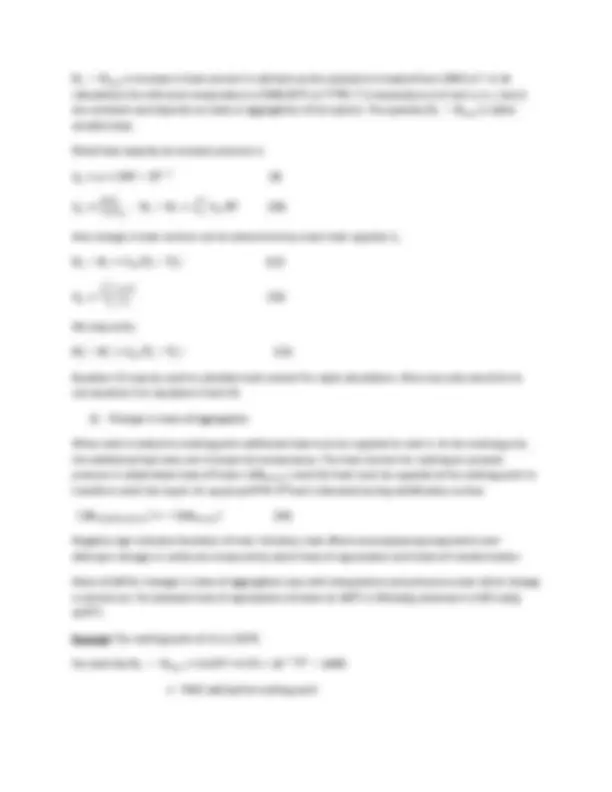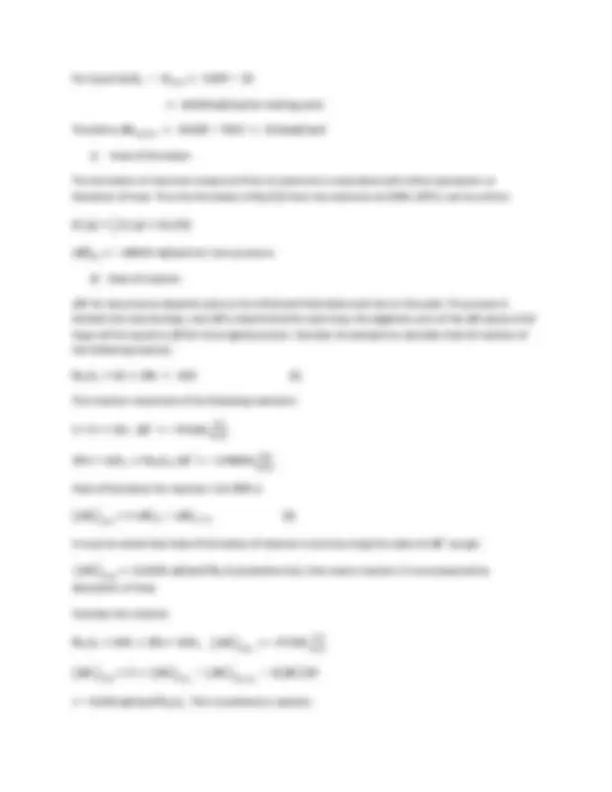





Study with the several resources on Docsity

Earn points by helping other students or get them with a premium plan


Prepare for your exams
Study with the several resources on Docsity

Earn points to download
Earn points by helping other students or get them with a premium plan
Community
Ask the community for help and clear up your study doubts
Discover the best universities in your country according to Docsity users
Free resources
Download our free guides on studying techniques, anxiety management strategies, and thesis advice from Docsity tutors
This lecture explores the basics of thermodynamics and thermochemistry, focusing on the calculation of heat effects during chemical reactions. Topics include the first law of thermodynamics, various heat effects, and examples. Keywords: thermochemistry, heat of formation, heat of reaction, kirchhoff's law.
Typology: Study notes
1 / 5

This page cannot be seen from the preview
Don't miss anything!




Lecture 6: Thermochemistry Contents Preamble First law of thermodynamics Various heat effects Conclusions References Key words: thermo chemistry, Heat of formation, Heat of reaction, Kirchoff’s law Preamble All chemical processes involve various kinds of energy interchanges with the surrounding. Heat energy is the principal form of energy exchange between metallurgical systems and its surrounding in various extraction and refining of metals. Thermo chemical calculations are required to perform energy balance of a process. Thermo chemical calculations are concerned with chemical changes that are accompanied by liberation or absorption of heat; for example 2Fe 1.5Oଶ ൌ Feଶ O (^) ଷ ଶ ൌ CO (^) ଶ
ଶ O^ ଷ .5 ൈ 10ଷ^ ଶ O^ ଷ ൈ 10ଷ^ ଶ
understood ଶ ଵ th^ h. Since ∆E is independent of the path, ሺQ െ Wሻ is also independent of path. However Q and W represent e and ar
and C O The formation of Fe is accompanied by evolution of 196 kcal of heat per kg mole of Fe. Similarly94.0.5 kcal of heat per kg mole is evolved when carbon on combustion produces CO. This lecture deals with basics of calculation of heat evolved or absorbed during a chemical reaction. Suitable examples are given to illustrate the basics of calculations. First law of thermodynamics : In the following, only a brief account is given. The first law equation for a process occurring is a systems is
and are energy contents (internal energies) of the system in state 1 and state 2 (it must be clearly that thermodynamics deals with initial and final states), Q is the heat absorbed by the system from the surrounding and W is work done by the systems on the surrounding. Since E and E depend only on final and initial state of a systems, change in energy ∆E is independent of e pat
energy xchange with the surrounding e not thermodynamic properties of the system. For
example, if for a given change in state by a path, heat Q absorbed is more than that path will also correspond to more work, W. Some of the paths treated in thermodynamics are constant pressure, econstant volume, adiabatic (Q=0) and reversible ones. Extraction of metals is mostly carried at 1 atmospheric pressure. For constant pressure processes, more useful form of first law can be derived. The heat content or enthalpy of systems (H) is a thermodynamic property H ൌ E PV (2)
Expansion work ൌ p dVଵଶ ଶ ൌ Pଵ ൌ p
W ൌ PሺVଶ െ Vଵ ሻ
In equation Q (^) P is heat absorbed by system in changing from state 1 to state 2 by a path of constant h If an isobaric processes involves work other than expansion ∆H ൌ Q (^) P െ W ଵ^ (7) W 1 does not include expansion work. For example in an electric process at constant pressure –W^1 is
The equation 6 is very useful since Q (^) P is related to the heat content (H). The change in heat content ∆H es
Various heat effects a) Effect of temperature The variation of heat content in pure compounds with temperature can be determined by HT െ H (^) ଶଽ଼ ൌ aT bT cT d (8)
P is pressure and V is volume of the system. With the help of equation 1, first law is written for any thermodynamic change of state: (3) For a constant pressure process, only expansion work is done by system on surrounding and is equal to also P (4) (5) By 3,4 and 5 we get or ∆H (6)
pressure. A c ange under constant pressure is 1 called “ISOBARIC process”.
input of electrical work to the system.
depends on the initial and final stat only; hence heat absorption or evolution can be evaluated form the data on the properties of system in the two states.
ଶି ଵ
For liquid Cu H (^) T െ H (^) ଶଽ଼ ൌ 7.50T െ 20 ൌ 10158 cal/mol t melting point 10158 െ 7042 of formation The formation of chemical compound from its elements is associated with either absorption or of H (^) ଶ Oሺlሻ form the elements at 298K ሺ25Ԩሻ can be written
a Therefore ∆H୳ୱ୧୭୬ ൌ ൌ 3116cal/mol c) Heat
liberation of heat. Thus the formation
H (^) ଶ ሺgሻ ଵଶ O (^) ଶ ሺgሻ ൌ H (^) ଶ Oሺlሻ
∆H (^) ଶଽ଼^ ൌ െ68320 cal/mol at 1 atm pressure d) Heat of reaction ∆H for any process depends only on the initial and final states and not on the path. If a process is , and ∆H is determined for each step, the algebraic sum of the ∆H values of all steps will be equal to ∆H for the original process. Consider an example to calculate heat of reaction of the 3 of the following reactions:
C O ൌ CO ; ∆H °^ ൌ െ29160 (^) ୫୭୪ୣ
divided into several steps
following reaction: Feଶ O (^) ଷ 3C ൌ 2Fe CO (1) This reaction comprises ୡୟ୪
2Fe 1.5O (^) ଶ ൌ Feଶ O (^) ଷ ; ∆H °^ ൌ െ198500 (^) ୫୭୪ୣୡୟ୪
Heat of formation for reaction 1 at 298K is
൫∆H (^) °^ ൯ଶଽ଼ ൌ 3 ∆H (^) CO°^ െ ∆H (^) Fୣ°^ మ O (^) య (2)
nt is zero by using the value of ∆H °^ we get ൫∆H (^) °^ ൯ଶଽ଼ ൌ 111020 cal/mol F , that means reaction 1 is accompanied by absorption of heat. Consider the reaction
3COଶ ൫∆H (^) °^ ൯CO (^) మൌ െ97200 (^) ୫୭୪.ୡୟ୪
It must be noted that heat of formation of eleme
eଶ O (^) ଷ(endothermic)
Feଶ O (^) ଷ 3CO ൌ 2Fe
൯CO (^) మെ ൫∆H (^) °^ ൯Fୣ (^) మ O (^) యെ 3൫∆H (^) °^ ൯CO
ൌ െ5620 cal/mol Fe (^) ଶ O (^) ଷ. This is exothermic reaction.
The heat of reaction calculated above are at 298K ሺ25Ԩ. Heat of reaction depends on temperature and can be determined ൫∆H (^) °^ ൯Tమൌ ሺ∆H (^) ሻ (^) ଶଽ଼ ∑ሺH (^) Tଶ െ H (^) ଶଽ଼ ሻ (^) ୮୰୭ୢ୳ୡ୲ୱ ۛ ∑൫H (^) Tమ െ H (^) Tభ ൯୰ୣୟୡ୲ୟ୬୲ୱ 15)
lecture discusses the basics of thermo chemistry as required to calcu es of heat associated with a chemical reaction. Heat of formation, latent heat of fusion, evaporation and are discussed and illustrated with a suitable example. Effect of temperature on heat of given. For details the readers may go through the references.
Alan and Geiger: energy balance in metallurgical processes
Conclusion This late the different typ
transformation reaction is also References: Schuhmann: Metallurgical Engineering Principles